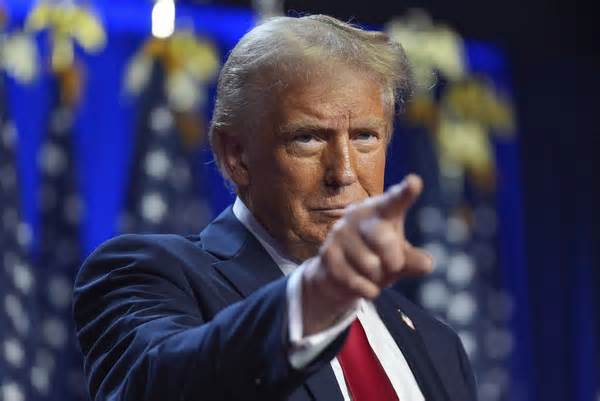
Trump victory rattles US energy policy
- by E&E
- Nov 06, 2024
- 0 Comments
- 0 Likes Flag 0 Of 5

By Peter Behr, Brian Dabbs | 11/06/2024 07:19 AM EST
The former president’s return to the White House boosts the oil industry and raises questions about the future of the Inflation Reduction Act.
President-elect Donald Trump arrives at an election watch party Wednesday in West Palm Beach, Florida.
Evan Vucci/AP
Donald Trump’s reelection as president Wednesday marks a jarring reversal of national energy objectives — from President Joe Biden’s agenda to more “drill, baby, drill” politics in Washington.
Trump’s victory comes 2 ½ months after the Democratic National Convention in late August, where Vice President Kamala Harris accepted her party’s nomination after President Joe Biden dropped out of the race.
In a speech early Wednesday morning, Trump signaled new policies to boost U.S. oil and gas.
Advertisement
“We have more liquid gold than any country in the world,” he told a raucous crowd in West Palm Beach, Florida.
Trump vowed to cut taxes, reduce the debt, “stop wars,” and “seal up” U.S. borders. He said the American public gave Republicans a “powerful mandate.” He also called Elon Musk, CEO of the electric vehicle company Tesla and a Trump campaign ally, a “star.”
The battle for the White House and Congress, which led to Republicans flipping the Senate, was fought in Pennsylvania, the Upper Midwest, the Southeast and Western states. In the final weeks of the campaign, Harris leaned on the resurgence in domestic manufacturing tied to Biden’s biggest legislative victories. In Michigan, Trump sought to cast a pillar of that — electric vehicles — as an attack on jobs tied to the traditional gasoline-consuming cars most Americans still drive.
Trump’s victory in Wisconsin put him over the top, giving him 277 electoral votes. As of publication time, he also had clinched major battlegrounds like Pennsylvania, Georgia and North Carolina. If current projections hold, the president-elect would surpass 300 electoral college votes. Trump dominated rural counties with large white populations, and exit polls suggested the former president made big gains among Latino voters.
As of publication time, the Harris team had not yet conceded or spoken publicly.
Republicans will also retake control of the Senate in 2025 after flipping seats in West Virginia and Ohio. The House is too early to call, and control of that chamber could be undecided for days or weeks. The ultimate outcome could be critical in determining how much of a rubber stamp Trump will have on his agenda.
In a statement, South Dakota Sen. John Thune, a top Republican vying to replace Sen. Mitch McConnell (R-Ky.) as majority party leader, said the incoming Republican majority will “work hand in hand with the Trump-Vance administration” to “renew America’s energy dominance.”
The U.S. already produces record volumes of both oil and natural gas.
In his speech, Trump vowed to “help our country heal” in a “new golden era of America,” a sharp contrast from months of vitriol on the campaign trail. He also called Hurricane Helene, which ravaged North Carolina in late September and claimed more than 200 lives, a “water hurricane” that was “as big as we’ve ever seen.” The term “water hurricane” is not one used by scientists, but the storm unleashed record rainfall and flooding, which many attribute to climate change.
Dana White, CEO of the cage-fighting league Ultimate Fighting Championship, spoke alongside Trump on Wednesday morning. White called Trump the “most resilient, hard-working man I’ve ever met.”
The 180-degree turn after Trump enters the White House in January is expected to reach far beyond Washington. Energy investors on Wall Street and in Silicon Valley and auto and battery makers in the industrial Midwest and in the South all have a stake in Trump’s push to redirect priorities away from clean energy.
In what has become a ritual for incoming presidents, Trump is expected to sign executive orders during his first week — and perhaps first hours — in the Oval Office. Trump has vowed to pull the United States out of the Paris climate agreement, as he did in 2017. The Biden administration is dispatching a delegation to climate negotiations this month in Baku, Azerbaijan. With the U.S. the second-highest emitter behind China, the Trump victory could upend international collaboration on emissions reduction.
Trump and his conservative supporters say cutting energy emissions by turning away from fossil fuels are only hurting American consumers by driving up energy costs to chase an unreachable goal.
Trump has also vowed to end the “Green New Scam” — spending under Biden to spur new clean energy manufacturing and power generation — and use the money instead to build roads and bridges.
A critical test for Trump would come if he tries to scrap the 2022 Inflation Reduction Act, with its grants and long-term tax incentives for wind, solar, utility storage batteries, transmission lines and EVs. Republican support for new clean energy manufacturing operations could stymie spending clawbacks, but Trump’s administration could halt new grants and weaken incentives with changes in tax regulations, his advocates say.
On Tuesday night before the race was called, Andrew Reagan, executive director of the group Clean Energy for America Action, which ran ads in favor of Harris, said in a statement “the clean energy boom is here to stay.”
Reversing Biden administration regulations on fossil fuels is high on Trump’s agenda, according to observers. He has vowed to undo Biden’s freeze on new permits to export liquefied natural gas to most trading partners. Biden ordered the hold in January to allow a study of LNG’s environmental impacts, a restriction climate action supporters had demanded. The pause was tossed out by the U.S. District Court for the Western District of Louisiana in July.
LNG production was at the top of Trump’s agenda in 2017, opening markets for increased U.S. fossil fuel drilling and production and giving Trump a bargaining chip for negotiations with foreign leaders whose countries wanted the U.S. energy.
Between 2017 and this year, average monthly U.S. LNG exports soared 400 percent and under Trump will continue to climb, adding more exports to the U.S. trade balance.
Trump’s re-embrace of fossil fuels will occur as the U.S. is losing the battle to control planet-warming carbon dioxide emissions. EPA estimated in April that greenhouse gas emissions climbed 1 percent in 2022 as the economy recovered from the Covid-19 pandemic.
The victory comes as power markets and utilities are projecting record increases in demand from a combination of data centers, industrial growth and electric cars. Electrification in a growing U.S. economy is raising concern about rising greenhouse gas emissions, at least until more wind and solar power can be unlocked. Natural gas-fueled power plants account for almost 40 percent of electricity generation.
Lessons from 2016
In many ways, Trump left behind a playbook on how he would steer energy policy through his budget requests as president. While those proposed budgets never became law because of pushback from both Democrats and Republicans on Capitol Hill, they signal Trump would try to steer the Department of Energy in a sharply different direction, with a move away from deploying large projects intended to cut emissions. Instead, the focus would be on early-stage research.
Trump, for example, repeatedly proposed eliminating DOE’s loan office and the Advanced Research Projects Agency-Energy, the department’s innovation arm. He called for slashing DOE’s renewable office by more than half, and cutting electric vehicle programs. He also stalled many efficiency rules for appliances, complaining about regulations for showerheads and less wasteful lightbulbs that he said made him look orange.
Trump’s current platform, Agenda 47, echoes many of those themes, calling for increased oil and gas production and fewer energy regulations. It calls hydrogen and carbon capture and sequestration (CCS) — both priorities of the Biden administration — “untested technologies.”
One industry where Trump may find agreement with Democrats is on nuclear, although he proposed cuts to DOE’s nuclear programs while previously in office. According to Agenda 47, Trump would work to keep existing plants open and invest in small modular reactors, which are similar policies to Biden. Trump also pledged to modernize the Nuclear Regulatory Commission.
“We should ensure a clear and expedient pathway for advanced, micro and modular reactors to reach commercialization,” Trump’s website says.
Trump’s vow to impose import taxes of 60 percent on Chinese goods and 15 to 50 percent on other nations’ imports could ignite inflation and trigger a trade war, economists have warned.
A severe China tariff could have the greatest impact on stressed U.S. energy infrastructure, inflating prices for crucial Chinese-sourced grid components that are hard or impossible to buy in this country or from friendly nations.
“It makes no sense,” said former Energy Secretary Ernest Moniz about Trump’s tariff plan. “Whether it’s on China or on friends and allies, there’s always going to be retaliation. There will be direct cost impacts on consumers.” And there are specific products that U.S. industries cannot get elsewhere, from railroad car-sized transformers to critical power controls, he added.
Oil and gas producers have also expressed concerns over tariffs on steel and other imports used at drill sites.
A group of 23 Nobel Prize-winning economists backed Harris’ economic plans, saying they would “improve our nation’s health, investment, sustainability, resilience, employment opportunities, and fairness and be vastly superior to the counterproductive economic agenda of Donald Trump.” Trump said the economists were “worthless” and “out of touch.”
Can the grid grow under Trump?
Trump’s win increases the need to rethink where America is headed on clean energy, said Moniz.
Uncertainty about the shape of regional power grids, where supply is struggling to keep up with volatile demand, is example No. 1. “We need to be pragmatic. We can’t exclude possible solutions,” Moniz said.
A crucial test following Trump’s election is whether he supports or opposes possible bipartisan support to speed up energy infrastructure siting and permitting.
Trump may choose to jam the gears of a three-year campaign by Biden’s Department of Energy to support a historic investment by the power sector in doubling or tripling the capacity of the country’s high-voltage grid.
Biden’s White House climate adviser Ali Zaidi commented recently that given the broad benefits, grid infrastructure shouldn’t be just another issue that Republicans and Democrats go to war over, but it has been. It’s unclear where Trump stands.
“I can’t make heads or tails of what Trump would do with energy policy,” said energy analyst and clean power advocate Rob Gramlich, president of Grid Strategies LLC.
A larger, stronger grid is a key to expanding delivery of wind and solar power, while enabling neighboring regions to share more power in extreme weather emergencies, and injecting more price competition in power markets, as a new DOE grid study documents.
DOE has helped overcome permitting holdups on a half dozen big wires projects and stepped in with financial support. It has awarded $7.6 billion to 104 wires projects under its primary grid support program, adding 50,000 megawatts of new power transformer capacity.
“There’s much more to come,” Energy Secretary Jennifer Granholm said in August. But next year, DOE’s grid office will report to Granholm’s replacement, who may be following a game plan to drastically cut the department’s size and clean energy investments.
Red state money
Project 2025, a detailed conservative roadmap for shrinking the federal government and Democrats’ policy initiatives has been disavowed by Trump. But his allies wrote it, and he has backed much of its agenda. Project 2025 states “taxpayers should not be backing risky business ventures or politically preferred commercial enterprises.”
With Trump likely bent on clawing back unobligated Biden clean energy grants and razing his agenda, forward momentum would depend even more on states, utilities, and large energy users with the goal of cutting carbon pollution.
Nine states have let their renewable energy goals lapse. Two states rescinded their goals, and 11 states divided between the Great Plains and Southeastern regions never had goals in the first place.
Attorneys general in 25 states in July went to court to try to block EPA’s power plant carbon emissions controls, while 22 state AGs defended the EPA rule. The two sides are a nearly exact match to the red and blue state political divide.
However, many of the clean energy investments from the IRA and infrastructure law are benefitting Republican-leaning areas.
Just over half of the funding from the Inflation Reduction Act and the CHIPS and Science Act has gone to red states that gave Trump strong pluralities. Only 15 percent flowed to safe Democratic states, with the rest spread among swing states, according to a Fitch Ratings service analysis for CNN this year.
The consulting firm Wood Mackenzie predicted before the election that Trump would not find enough congressional votes to repeal the Inflation Reduction Act. However, if Trump ends up with GOP majorities in both chambers of Congress, the IRA tax incentives could be significantly pared back.
Ultimately, exit polls from Tuesday’s results will be pored over for signs that Americans’ political attitudes on clean energy are changing.
No doubt many Americans will happily turn their backs on the 2024 election, with its super-heated denunciations and emotions, the assassination attempts, and dark fears on both sides.
Following it, however, is a new chapter of uncertainty — and more peril from an increasingly dangerous climate.
Related Articles
Please first to comment
Related Post
Stay Connected
Tweets by elonmuskTo get the latest tweets please make sure you are logged in on X on this browser.
Sponsored
Popular Post
Tesla: Buy This Dip, Energy Growth And Margin Recovery Are Vastly Underappreciated
28 ViewsJul 29 ,2024






 Energy
Energy


















